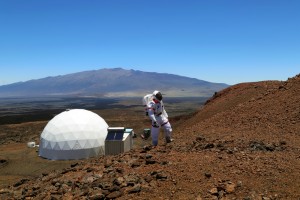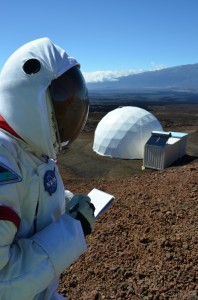05 Aug Mars via Hawaii! Remote Habitat Journey

A research team is about to end their long-duration space journey – spending more than 100 days inside a remote habitat.
The HI-SEAS study is led by Cornell University and the University of Hawai‘i at Mānoa, work is funded by the NASA Human Research Program.
The Hawaii Space Exploration Analog and Simulation (HI-SEAS) makes use of a long-duration space exploration home on the slopes of Mauna Loa on the Island of Hawaii.
The group of six researchers will conclude their mission on August 13.

The work is funded by the NASA Human Research Program, with one key bit of research “on the menu”: Analyzing new types of food and novel food preparation strategies to keep astronauts well-nourished for space exploration.
Winning recipe
These Earth-based researchers have been living and working like astronauts, including suiting up in space gear whenever they venture outside a simulated Martian base and cooking meals from a specific list of dehydrated and shelf-stable food items, according to a press statement from the University of Hawai‘i at Mānoa.
The food study is designed to simulate the living and working experience of astronauts on a real planetary mission and to compare two types of food systems – crew-cooked vs. pre-prepared – as thoroughly as possible in the context of a four-month Mars analog mission.
BTW: At the end of the study, researchers will announce the winners of the HI-SEAS recipe contest!
Slope of Mauna Loa
The HI-SEAS Habitat is positioned at roughly 8,000 feet (2.5 kilometers) elevation in an abandoned quarry on the northern slope of Mauna Loa. It lies next to an escarpment formed from a string of cinder cones dotting a collapsed lava tube. The site contains little vegetation, no rare, threatened or endangered species, and no archaeological sites or cultural practices.
The two-story habitat is based on a dome supplied by Pacific Domes International and its internal layout is designed by V. Paul Ponthieux of Envision Design, and built by the Blue Planet Foundation of Honolulu, Hawaii.
The geodesic dome is 36 feet (11 meters) in diameter, enclosing a volume of 13,570 cubic feet.
The ground floor has an area of 993 square feet (878 square feet usable) and includes common areas such as kitchen, dining, bathroom with shower, lab, exercise, and common spaces.
The second floor loft spans an area of 424 square feet and includes six separate staterooms and a half bath. In addition, a 160 square foot workshop converted from a 20-foot high steel shipping container is attached to the habitat.
Earth-bound analog
The NASA Human Exploration & Operations Mission Directorate has identified a number of risks associated with long-term human space exploration. Many of these can be fruitfully investigated in an Earth-bound analog environment – that is, somewhere on Earth that is similar to the target space environment in relevant ways.
This first HI-SEAS mission involved six astronaut-like (in terms of education, experience, and attitude) crewmembers living in the habitat under Mars-exploration conditions, such as communication latencies and blackouts, in close quarters, under strict water-use rules, etc. The crew was selected from over 700 applicants.



Sorry, the comment form is closed at this time.